
Dessert is a course that concludes a meal. The course consists of sweet foods, such as cake, biscuit, ice cream and possibly a beverage such as dessert wine and liqueur. Some cultures sweeten foods that are more commonly savory to create desserts. In some parts of the world there is no tradition of a dessert course to conclude a meal.

Sicilian cuisine is the style of cooking on the island of Sicily. It shows traces of all cultures that have existed on the island of Sicily over the last two millennia. Although its cuisine has much in common with Italian cuisine, Sicilian food also has Greek, Spanish, French, Jewish, Maghrebi, and Arab influences.
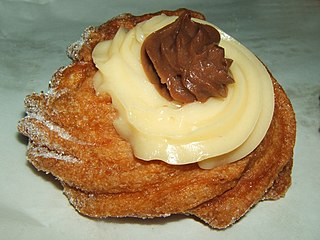
Zeppola, in Sardinia italianized zippole or zeppole sarde from the original Sardinian tzípulas, is an Italian pastry consisting of a deep-fried dough ball of varying size but typically about 4 inches (10 cm) in diameter. This fritter is usually topped with powdered sugar, and may be filled with custard, jelly, cannoli-style pastry cream or a butter-and-honey mixture. The consistency ranges from light and puffy, to bread- or pasta-like. It is eaten to celebrate Saint Joseph's Day, which is a Catholic feast day.

A buccellato is a Sicilian circular cake made from pastry dough filled with figs and nuts. In Sicily, it is traditionally associated with Christmas.
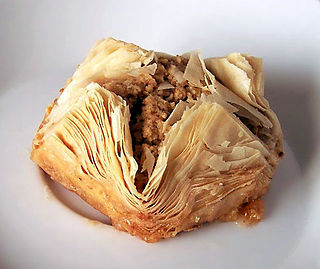
Filo is a very thin unleavened dough used for making pastries such as baklava and börek in Middle Eastern and Balkan cuisines. Filo-based pastries are made by layering many sheets of filo brushed with oil or butter; the pastry is then baked.

Arancini, also known as arancine, are Italian rice balls that are stuffed, coated with breadcrumbs and deep-fried. They are a staple of Sicilian cuisine. The most common arancini fillings are al ragù or al sugo, filled with ragù, mozzarella or caciocavallo cheese, and often peas, and al burro or ô burru, filled with ham and mozzarella or béchamel sauce.

Iraqi cuisine is a Middle Eastern cuisine that has its origins in the ancient Near East culture of the fertile crescent. Tablets found in ancient ruins in Iraq show recipes prepared in the temples during religious festivals—the first cookbooks in the world. Ancient Mesopotamia was home to a sophisticated and highly advanced civilization, in all fields of knowledge, including the culinary arts.

Cassata or cassata siciliana is a traditional cake from the Sicily region of Italy. Cassata is typically composed of a round sponge cake moistened with fruit juices or liqueur and layered with ricotta cheese and candied fruit. Cassata has a shell of marzipan, pink and green colored icing, and decorative designs. Cassata may also refer to a Neapolitan ice cream containing candied or dried fruit and nuts.

Sfogliatella, sometimes also known in the United States as a lobstertail, is a shell-shaped pastry with a sweet or creamy filling, originating in the Campania region of Italy. Sfogliatella means 'small, thin leaf/layer', as the pastry's texture resembles stacked leaves.
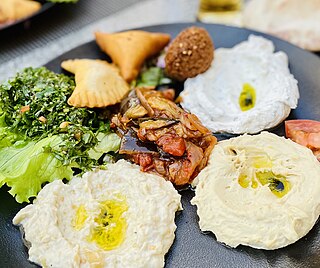
Ma'amoul is a filled butter cookie made with semolina flour. It is popular throughout the Arab world. The filling can be made with dried fruits like figs, dates, or nuts such as pistachios or walnuts, and occasionally almonds.

Knafeh is a traditional Arabic dessert, made with spun pastry called kataifi, soaked in a sweet, sugar-based syrup called attar, and typically layered with cheese, or with other ingredients such as clotted cream, pistachio or nuts, depending on the region. It is popular in the Middle East.

Baklava is a layered pastry dessert made of filo pastry, filled with chopped nuts, and sweetened with syrup or honey. It was one of the most popular sweet pastries of Ottoman cuisine, it is also popular in both Iranian (Persian) and Greek cuisine.
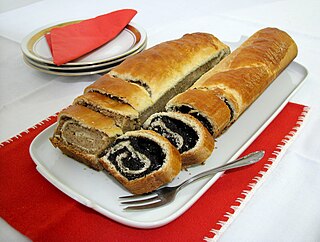
The poppy seed roll is a pastry consisting of a roll of sweet yeast bread with a dense, rich, bittersweet filling of poppy seed. An alternative filling is a paste of minced walnuts, or minced chestnuts.

The gelo di melone, also known as gelo d'anguria, is a typical Sicilian dessert, traditionally prepared in Ferragosto. A jellied watermelon pudding, it is also popular for the Saint Rosalia celebrations in Palermo.

A pasticciotto is a type of filled Italian pastry. Depending on the region, they are traditionally filled with either ricotta cheese or egg custard.
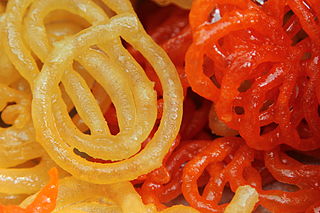
Zalabiyeh is a fritter or doughnut found in several cuisines across the Arab world, West Asia and some parts of Europe influenced by the former. The fritter version is made from a semi-thin batter of wheat flour which is poured into hot oil and deep-fried. The earliest known recipe for the dish comes from a 10th-century Arabic cookbook and was originally made by pouring the batter through a coconut shell.

Sfincia di San Giuseppe is a Sicilian pastry dessert, traditionally prepared for the day of Saint Joseph. It is recognised as prodotto agroalimentare tradizionale (PAT) by the Italian Ministry of Agricultural, Food and Forestry Policies.
Lauzinaj, also spelled lawzinaj, lawzinaq, luzina is an almond-based confection known from medieval Arab cuisine. Described as the "food of kings" and "supreme judge of all sweets", by the 13th-century lauzinaj had entered medieval European cuisine from the Andalusian influence, returning Crusaders and Latin translations of cookery books.




















